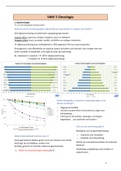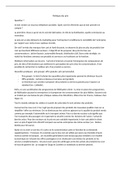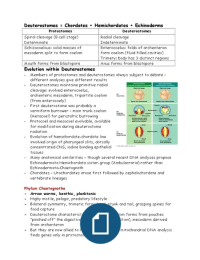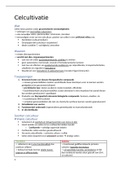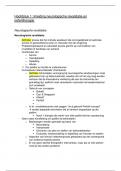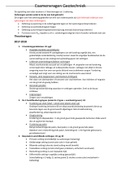Checklist theme 5
Week 17
• Students are familiar with the classifications somatic symptom disorder, functional neurological symptom disorder,
illness anxiety disorder, ‘somatic disorder affected by psychiatric factors’ and factitious disorder (in line with the
DSM-V criteria) (introductory lecture).
Factitious disease
oddballs among psychiatric disorders
they don’t have an actual illness but allow others to believe that they do by feigning one
this pretence is itself regarded as pathological if there are no understandable external motives for it!
Factitious disorder imposed on oneself = Münchhausen syndrome
Factitious disorder imposed on another = Münchhausen syndrome by proxy
Münchhausen syndrome criteria:
A = Falsification of physical or psychological signs or symptoms or induction of injury or disease, associated with
identified deception
B = the individual presents himself or herself to others as ill, impaired or injured
C = the deceptive behaviour is evident even in the absence of obvious external rewards
Münchhausen syndrome by proxy criteria
A = Falsification of physical or psychological signs or symptoms or induction of injury or disease, in another,
associated with identified deception
B = the individual presents another individual (victim) to others as ill, impaired or injured
C = the deceptive behaviour is evident even in the absence of obvious external rewards
Somatic symptom disorder: 20% experiences it during their lifetime (most temporary)
Cause: - serious life events to acute stress
situations to medical conditions (e.g. infection +
fever, orthopedic trauma)
- Trauma in early life
- cluster B or C personality, impaired emotional
regulation, chronic stress
Onset/course: mild cases usually short, severe
cases usually chronic. More in women.
Symptoms: >1 somatic symptoms (e.g. pain,
fatigue, diarrhea, constipation), persistent
thoughts about seriousness symptoms, frequent
worrying, difficulty sleeping, panic attacks
Mild: only 1 of criteria B. Moderate is 2 or more
and severe is more than 2 and multiple physical sever symptoms.
Hetero anamnesis: excessive time and energy devoted to symptoms, avoidance behavior (passive or active), lying in
bed all day, irritability, preoccupation with having/acquiring a serious disease
Treatment: Clear explanation in multidisciplinary consultation
Psychotherapy: CBT improving function + reattribution; PST, IPT, mentalization-based therapy, mindfulness
based stress reduction
Pharmacology: Antidepressants, analgesics, anxiolytics, antipsychotics (functional dyspepsia), anticonvulsants
(chronic pain syndromes)
The psychiatrist makes the diagnosis and the treatment plan.
, Functional neurological symptom disorder (=conversion disorder)
Cause: reduced conscious control of their perception and motor function; inhibition of normal movement and failure
to activate normal movement (dysregulation of dorsolateral & orbito-frontal cortex + centers that regulate emotion)
- Psychodynamic theory: conversion due to rejection to unwanted impulses (tremor gets worse when
attention is paid to it)
- Learning theory: learned rejection to unwanted stimulus
Onset/course: presentation can be mixed; acute cases usually short & self-limiting; chronic & poor prognosis with
underlying personality disorder. 6% of GP visits, but 10% of neurological ward.
Symptoms: weakness/paralysis of limb, inability to walk (abasia)/stand (astasia), dysphagia, aphonia, neurological
movement disorder, diminished sensation/olfaction, sudden blindness/hearing loss, pseudoepileptics seizures,
tremor increasing when attention payed to it, inconsistent movement (ampl. freq.), inconsistent hypoaethesia
Diagnosis: Neurological tests (+ lumbar puncture, MRI, EEG, evoked potential test). Symptoms are incompatible with
known neurological or other medical conditions
Treatment: clear explanation in multidisciplinary consultation. Psychotherapy: cog. rehabilitation training, hypnosis
Illness anxiety disorder (=hypochondriasis)
Cause: serious life events to acute stress situations to medical conditions (e.g. infection + fever, orthopedic trauma).
Trauma in early life, cluster B or C personality, impaired emotional regulation, chronic stress.
Symptoms: No or mild symptoms present. Excessive worrying + anxiety and concern about physical sensations &
their consequences
for at least six months!!
Tests: to rule out medical conditions
Treatment: clear explanation in multidisciplinary consultation.
Psychotherapy: cognitive therapy, outreach approach if avoidance behavior
Pharmacology: antidepressants, anxiolytics
Somatic disorder affected by psychiatric factors
A medical symptom or condition is present, and made worse by behavioural or psychological factors.
factors influence the course of the medical condition, interferes with the treatment or constitute health risks, or
influence the underlying pathophysiology.
• Students are familiar with the occurrence and course of medically unexplained physical symptoms (MUPS) and
somatic symptom disorder (introductory lecture).
Medically unexplained symptoms: most commonly: fatigue (36%), headache (34%), sleeplessness (24%),
shoulder/back pain, nose congestion
10-15% MUS in lifetime
50-75 of MUS symptoms disappear within 12-15 months and 20-30% becomes chronic
1/3 of GP is MUS
clusters: GI, cardio-pulmonal, musculoskeletal, general/nonspecific.
most common = IBS (40% at GI), Fibromyalgia (15% at rheumatology), chronic fatigue syndrome (internal meds)
1/3 of the patients develops depression/anxiety
Doctor / patient relationship: explain anatomy and
physiology, share doubts when you have them. Shared action
plan, realistic picture, listen to patient. Acknowledge
sufferering
Week 17
• Students are familiar with the classifications somatic symptom disorder, functional neurological symptom disorder,
illness anxiety disorder, ‘somatic disorder affected by psychiatric factors’ and factitious disorder (in line with the
DSM-V criteria) (introductory lecture).
Factitious disease
oddballs among psychiatric disorders
they don’t have an actual illness but allow others to believe that they do by feigning one
this pretence is itself regarded as pathological if there are no understandable external motives for it!
Factitious disorder imposed on oneself = Münchhausen syndrome
Factitious disorder imposed on another = Münchhausen syndrome by proxy
Münchhausen syndrome criteria:
A = Falsification of physical or psychological signs or symptoms or induction of injury or disease, associated with
identified deception
B = the individual presents himself or herself to others as ill, impaired or injured
C = the deceptive behaviour is evident even in the absence of obvious external rewards
Münchhausen syndrome by proxy criteria
A = Falsification of physical or psychological signs or symptoms or induction of injury or disease, in another,
associated with identified deception
B = the individual presents another individual (victim) to others as ill, impaired or injured
C = the deceptive behaviour is evident even in the absence of obvious external rewards
Somatic symptom disorder: 20% experiences it during their lifetime (most temporary)
Cause: - serious life events to acute stress
situations to medical conditions (e.g. infection +
fever, orthopedic trauma)
- Trauma in early life
- cluster B or C personality, impaired emotional
regulation, chronic stress
Onset/course: mild cases usually short, severe
cases usually chronic. More in women.
Symptoms: >1 somatic symptoms (e.g. pain,
fatigue, diarrhea, constipation), persistent
thoughts about seriousness symptoms, frequent
worrying, difficulty sleeping, panic attacks
Mild: only 1 of criteria B. Moderate is 2 or more
and severe is more than 2 and multiple physical sever symptoms.
Hetero anamnesis: excessive time and energy devoted to symptoms, avoidance behavior (passive or active), lying in
bed all day, irritability, preoccupation with having/acquiring a serious disease
Treatment: Clear explanation in multidisciplinary consultation
Psychotherapy: CBT improving function + reattribution; PST, IPT, mentalization-based therapy, mindfulness
based stress reduction
Pharmacology: Antidepressants, analgesics, anxiolytics, antipsychotics (functional dyspepsia), anticonvulsants
(chronic pain syndromes)
The psychiatrist makes the diagnosis and the treatment plan.
, Functional neurological symptom disorder (=conversion disorder)
Cause: reduced conscious control of their perception and motor function; inhibition of normal movement and failure
to activate normal movement (dysregulation of dorsolateral & orbito-frontal cortex + centers that regulate emotion)
- Psychodynamic theory: conversion due to rejection to unwanted impulses (tremor gets worse when
attention is paid to it)
- Learning theory: learned rejection to unwanted stimulus
Onset/course: presentation can be mixed; acute cases usually short & self-limiting; chronic & poor prognosis with
underlying personality disorder. 6% of GP visits, but 10% of neurological ward.
Symptoms: weakness/paralysis of limb, inability to walk (abasia)/stand (astasia), dysphagia, aphonia, neurological
movement disorder, diminished sensation/olfaction, sudden blindness/hearing loss, pseudoepileptics seizures,
tremor increasing when attention payed to it, inconsistent movement (ampl. freq.), inconsistent hypoaethesia
Diagnosis: Neurological tests (+ lumbar puncture, MRI, EEG, evoked potential test). Symptoms are incompatible with
known neurological or other medical conditions
Treatment: clear explanation in multidisciplinary consultation. Psychotherapy: cog. rehabilitation training, hypnosis
Illness anxiety disorder (=hypochondriasis)
Cause: serious life events to acute stress situations to medical conditions (e.g. infection + fever, orthopedic trauma).
Trauma in early life, cluster B or C personality, impaired emotional regulation, chronic stress.
Symptoms: No or mild symptoms present. Excessive worrying + anxiety and concern about physical sensations &
their consequences
for at least six months!!
Tests: to rule out medical conditions
Treatment: clear explanation in multidisciplinary consultation.
Psychotherapy: cognitive therapy, outreach approach if avoidance behavior
Pharmacology: antidepressants, anxiolytics
Somatic disorder affected by psychiatric factors
A medical symptom or condition is present, and made worse by behavioural or psychological factors.
factors influence the course of the medical condition, interferes with the treatment or constitute health risks, or
influence the underlying pathophysiology.
• Students are familiar with the occurrence and course of medically unexplained physical symptoms (MUPS) and
somatic symptom disorder (introductory lecture).
Medically unexplained symptoms: most commonly: fatigue (36%), headache (34%), sleeplessness (24%),
shoulder/back pain, nose congestion
10-15% MUS in lifetime
50-75 of MUS symptoms disappear within 12-15 months and 20-30% becomes chronic
1/3 of GP is MUS
clusters: GI, cardio-pulmonal, musculoskeletal, general/nonspecific.
most common = IBS (40% at GI), Fibromyalgia (15% at rheumatology), chronic fatigue syndrome (internal meds)
1/3 of the patients develops depression/anxiety
Doctor / patient relationship: explain anatomy and
physiology, share doubts when you have them. Shared action
plan, realistic picture, listen to patient. Acknowledge
sufferering


